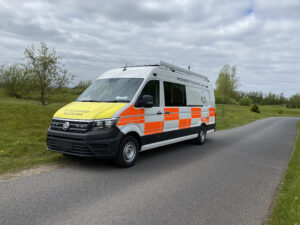Despite the fact there is a definite need to reduce C02 emissions because of global warming and poor air quality, companies that are heavily reliant on petrol and diesel-fuelled vehicles might find this difficult. Especially since the UK has pledged to reduce greenhouse gas emissions by 50 percent by 2025, compared to 1990 levels.
However, there are a number of technologies and initiatives that are helping to reduce vehicle emissions, which a lot of transport-based organisations can potentially capitalise on.
Plug-in Car and Van Grant
It is possible to get a grant towards the cost (the purchase price for the basic vehicle including number plates, vehicle excise duty and VAT) of a new electric car or van if it meets certain criteria. The grants are available for:
- 35% off the cost of a car, up to a maximum of £5,000
- 20% off the cost of a van, up to a maximum of £8,000
Plug-in refers to electric vehicles (EVs), plug-in hybrid electric vehicles (PHEVs), hydrogen fuel cell vehicles, and other technologies. Thankfully, the dealership will complete all paperwork and there are no application forms for you to fill in.
More info here – https://www.gov.uk/plug-in-car-van-grants/overview
Low Carbon Truck Trial
Launched in 2012, the low carbon truck trial was a bid to support UK road haulage operators in buying and using more eco-friendly heavy goods vehicles. Funding from the Office of Low Emission Vehicles (OLEV) and Innovate UK (formerly the Technology Strategy Board) was made available via a competition.
Overall, 13 projects were provisionally accepted for funding, which included a majority of duel fuel vehicles, some dedicated gas vehicles and even vehicles running on used cooking oil.
The dual fuel gas system reported direct tailpipe C02 emission savings of between 12-16 per cent. However, the availability of these kinds of vehicles as well as the prevalence of refuelling stations was two key concerns.
Low Emission Zones (LEZ)
Environmental campaigners such as ClientEarth have argued that the UK has been breaching legal limits for nitrogen dioxide since 2010 in 16 different cities and regions including London, Manchester, Birmingham, and Glasgow. In response, it wants more Low Emissions Zones (LEZ) to be introduced up and down the country.
London is planning on introducing a LEZ from September 2020, with vehicles failing to meet emission thresholds being fined £12.50 per day. Fifteen more authorities, including Birmingham, Leeds, Newcastle-upon-Tyne, Sheffield, Southampton and York, have also received government funding to develop LEZs too.
One potential issue is that each authority can set its own LEZ emission criteria, meaning that vehicles might be acceptable in one region but receive a fine in another. However, the British Vehicle Renting & Leasing Association is working with the government to establish a national standard for emissions.
Plug-in Taxi Prize
In July this year, eight cities were shortlisted as part of the government’s £20 million plug-in taxi prize. Each of the potential winning schemes will receive a study into providing more environmentally friendly travel opportunities in their area.
The studies will gather information on how local authorities could use the money to reduce the cost of buying purpose-built taxis and installing charging infrastructure. The eight city councils shortlisted are Birmingham, Cambridge, Coventry, Dundee, Nottingham, Oxford, Sheffield, and West Yorkshire.
Transport Minister Andrew Jones said: “Plug-in taxis are cheaper to run, better for the environment and an example of Britain leading the way in an innovative industry. That is why government is investing £500 million in low emission vehicles over the next 5 years to make them an accessible and affordable choice for all.
Low Emission Bus Scheme
Building on the success of the Green Bus Fund, which delivered around 1,250 low emission buses onto England’s roads from 2009-2013, the government’s latest Low Emission Bus Scheme has similar objectives.
From 2015-2020, the scheme will attempt to increase the uptake of low and ultra-low emission busses, speeding up the transition to an ultra-low emission bus fleet across England and Wales while removing the need for subsidy support.
The Low Emission Bus Scheme will also support the improvement of local air quality and the OLEV’s commitment of attracting investment to the UK. Through a competitive bidding process, £30 million will be made available to local authorities in England and Wales as well.
Clean Vehicle Technology Fund (CVTF)
In 2014, the government announced funding of £5 million to improve the green credentials of more than 1,000 local authority vehicles such as buses, taxis, vans, fire engines and ambulances.
In total, seventeen local authorities across the UK were awarded grants to implement various polluting-reducing technologies as part of the 2014 Clean Vehicle Technology Fund (CVTF). Successful projects must monitor the effectiveness of these technologies but also provide insight to other local authorities that are considering green vehicle upgrades.
Transport Minister Baroness Kramer said: “The £5 million CVTF means councils can now lead the way on introducing greener vehicles on their local streets. We received imaginative applications from local authorities from across England – all the schemes will lower emissions in busy towns and cities.”
Yorkshire Ambulance Trust
In addition to receiving £166,000 from the CVTF, which will go towards the installation of solar panels on 175 NHS vehicles, the Yorkshire Ambulance Service has also implemented various emission reduction initiatives in recent years.
In 2010, it became the first ambulance service in the country to employ an Environmental and Sustainability Manager to work with fleet, estates, and procurement departments to reduce carbon emissions. An eco-friendly driver-training programme has also been introduced for both emergency and non-emergency vehicles.
On top of that, the Yorkshire Ambulance Service has been working with Leeds University on aerodynamic ambulances. Initial studies suggested that a potential saving of 20 per cent could be made by changing from box-shaped body ambulances to van conversions.
Share
Leave a Reply



